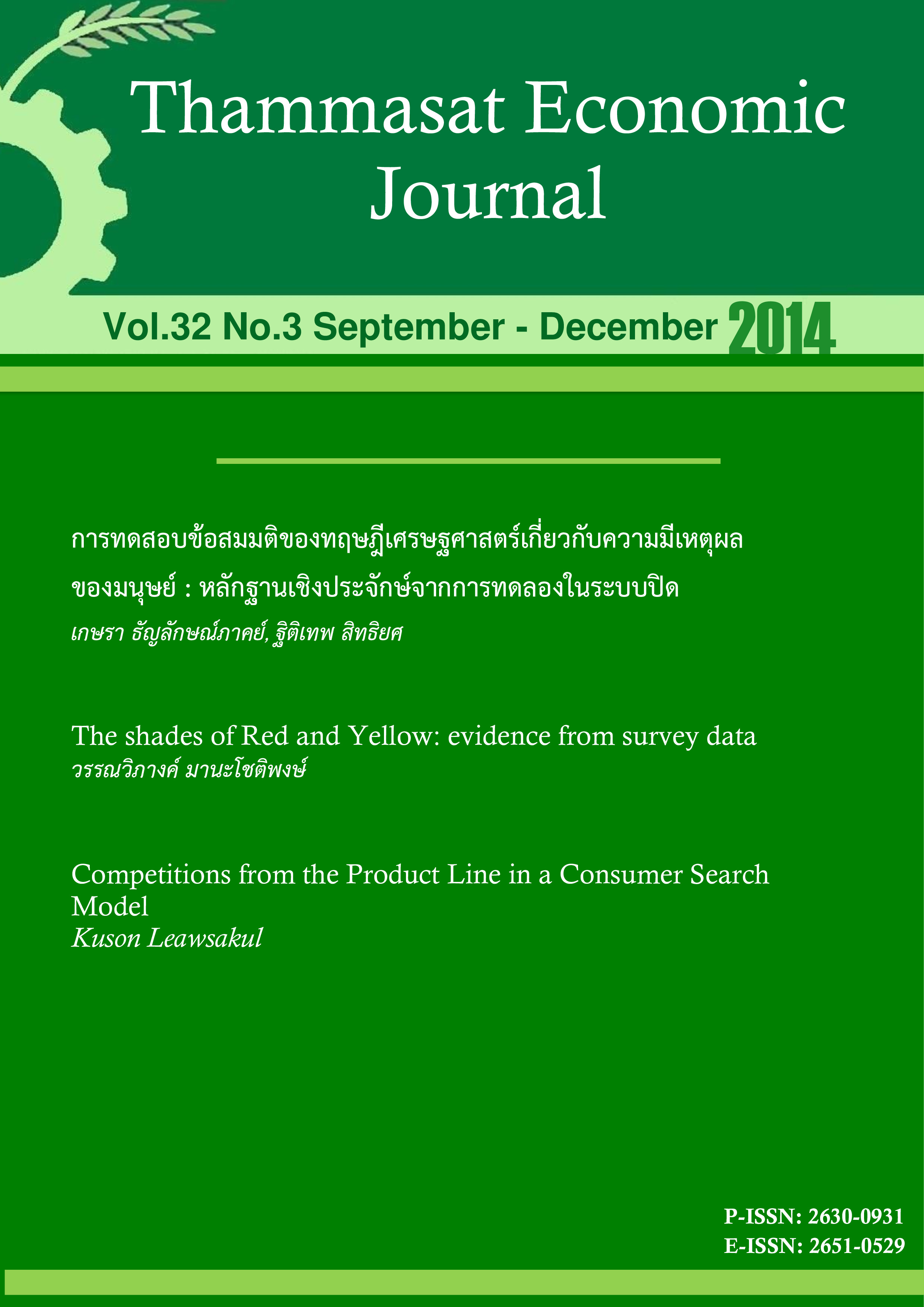Testing Rationality Assumptions in Economic Theory: Evidence from Closed Experiment
Keywords:
Economics, Psychology, Expected Utility and ChoiceAbstract
This study tests assumptions regarding human rationality, consistency, and decision-making process based on expected value as assumed in expected utility theory. The results from closed experiment using 24 graduate students from faculty of economics as a sample indicate that the majority of samples do not behave as the expected utility theory assumes. Rather, they show preference reversal and do not think in terms of expected value but use intuition. This study suggests that these unrealistic assumptions have to be abandoned and replaced with more realistic ones. Assuming rationality, consistency, and thinking process based on expected value for every decision-making has been proven by other fields of sciences as well as unorthodox economics that these behaviors are not consistent with actual human behaviors.
References
2.ทับทิม วงศ์ประยูร วันทนีย์ ภูมิภัทราคม ศักดิ์ชาย นาคนก และอัจฉราวรรณ สุขเกิด. (2550). หลักเศรษฐศาสตร์. กรุงเทพฯ: ธรรมสาร.
3.นราทิพย์ ชุติวงศ์. (2538). หลักเศรษฐศาสตร์ I: จุลเศรษฐศาสตร์. พิมพ์ครั้งที่ 2. กรุงเทพฯ: โรงพิมพ์จุฬาลงกรณ์มหาวิทยาลัย.
4.นิพิฐ วงศ์ปัญญา. (มิถุนายน 2556-มกราคม 2557). บทบาทของการสะสมสต็อกทุนมนุษย์และการหลุดออกจากกับดักรายได้ปานกลางของไทย. จดหมายข่าวเศรษฐกิจมหภาคและนโยบายทางเศรษฐกิจ. ฉบับที่ 4. หน้า 4-5.
5.ปิยดา สมบัติวัฒนา. (2554). การคิดเชิงบัญชีเพื่อการจัดการการเงินบุคคลของนิสิตปริญญาโท สาขาสังคมศาสตร์และพฤติกรรมศาสตร์ มหาวิทยาลัยศรีนครินทรวิโรฒ. วิทยานิพนธ์ปริญญาดุษฎีบัณฑิต. กรุงเทพฯ: มหาวิทยาลัยศรีนครินทรวิโรฒ.
6.พิทยา สิทธิอำนวย. (2553). การทดสอบทฤษฎี Prospect Theory ของ Kahneman และ Tversky กับกลุ่มตัวอย่างในประเทศไทย. วิทยานิพนธ์ปริญญามหาบัณฑิต. กรุงเทพฯ: มหาวิทยาลัยสุโขทัยธรรมาธิราช.
7.พิสิทธิ์ พัวพันธ์ วิภารัตน์ ปั้นเปี่ยมรัตน์ และจงกล คำไล้. (ตุลาคม 2555-พฤษภาคม 2556). การวิเคราะห์ผลกระทบนโยบายสวัสดิการสังคมต่อกรอบเศรษฐกิจและสังคมไทย. จดหมายข่าวเศรษฐกิจมหภาคและนโยบายทางเศรษฐกิจ. ฉบับที่ 3. หน้า 13-14.
8.พิสุทธิ์ กุลธนวิทย์. (2555). นโยบายการเงินแบบกำหนดเป้าหมายเงินเฟ้อภายใต้การเรียนรู้แบบปรับตัว: กรณีศึกษาประเทศไทย. วารสารเศรษฐศาสตร์ธรรมศาสตร์.คณะเศรษฐศาสตร์. มหาวิทยาลัยธรรมศาสตร์. ปีที่ 30. ฉบับที่ 3. หน้า 59-101.
9.ภาวิน ศิริประภานุกูล. (ตุลาคม 2555-พฤษภาคม 2556). การศึกษาปัจจัยก่อเกิดวัฏจักรธุรกิจและความสัมพันธ์กับนโยบายการเงิน. จดหมายข่าวเศรษฐกิจมหภาคและนโยบายทางเศรษฐกิจ. ฉบับที่ 3. หน้า 15-16.
10มนไท จันทร์ทอง. (2556). ภาวะหนี้สินของบุคลากรในกองอำนวยการรักษาความมั่นคงภายในราชอาณาจักร (ส่วนกลาง). วิทยานิพนธ์ปริญญามหาบัณฑิต. กรุงเทพฯ: มหาวิทยาลัยธุรกิจบัณฑิตย์.
11.เริงชัย ตันสุชาติ. (2550). ทฤษฎีเศรษฐศาสตร์จุลภาค: Microeconomic Theory. เชียงใหม่: โชตนาพริ้นท์.
12.วิศิษฎ์ ชัยศรีสวัสดิ์สุข. (2556). แบบจำลอง Overlapping Generation. เอกสารประกอบการสัมมนาโครงการศึกษาวิจัยหัวข้อ “ความยั่งยืนของรัฐสวัสดิการไทย (การศึกษาระยะที่ 1)” ณ โรงแรมเชอราตัน แกรนด์ สุขุมวิท. 22 มีนาคม 2556. คณะพัฒนาการเศรษฐกิจ สถาบันบัณฑิตพัฒนบริหารศาสตร์.
13.สุจิตรา กุลประสิทธิ์. (2552). เศรษฐศาสตร์จุลภาค. พิมพ์ครั้งที่ 2. กรุงเทพฯ: โรงพิมพ์ ออฟเซ๊ท.
14.สถาบันพัฒนาความรู้ตลาดทุน ตลาดหลักทรัพย์แห่งประเทศไทย. (2548). เศรษฐศาสตร์.กรุงเทพฯ: อมรินทร์พริ้นติ้งแอนด์พับลิชชิ่ง.
15.สุทิติ ขัตติยะ. (2555). เศรษฐศาสตร์นิเทศศาสตร์. กรุงเทพฯ: สำนักพิมพ์วัฒนาพาณิชย์.
16.Bardsley, N., Cubitt, R., Loomes, G., Moffatt, P., Starmer, C. and Sugden, R., (2010). Experimental Economics: Rethinking the Rules. New Jersey: Princeton University Press.
17.Bargh, J., (2014). Our Unconscious Mind. Scientific American, 310, 1, pp. 20-27.
18.Basu, K., (2014). The Ponzi Economy. Scientific American, 310, 6, pp. 54-59.
19.Beinhocker, E. D., (2007). The Origin of Wealth: Evolution, Complexity, and the Radical Remaking of Economics. London: Random House Business Books.
20.Boonprakaikawe, J. and Tournemaine, F., (มิถุนายน 2556-มกราคม 2557). Effects of Government Spending on Economic Growth, Inequality, and Population Density. จดหมายข่าวเศรษฐกิจมหภาคและนโยบายทางเศรษฐกิจ. ฉบับที่ 4. หน้า 9-16.
21.Buchanan, M., (2013). Forecast: What Physics, Meteorology and the Natural Sciences Can Teach Us about Economics. London: Bloomsbury.
22.Farmer, D., (2011). Macroeconomics from the Bottom up. 30 Ways to Be An Economist. Available from https://ineteconomics.org/video/30-ways-be-economist/doyne-farmer -macroeconomics-bottom [Accessed 30 August 2012].
23.Foerster, A., Rubio-Ramirez, J., Waggoner, D. and Zha, T., (2013). Perturbation Methods for Markov-Switching DSGE Models. Research Working Papers #13-01. The Federal Reserve Bank of Kansas City. Available from https://kansascityfed.org/ publications/research/rwp/rwp-2013.cfm [Accessed 8 March 2013].
24.Gigerenzer, G., (2013). Smart Heuristics, In J. Brockman, ed. Thinking: The New Science of Decision-Making, Problem-Solving, and Prediction. New York: Harper Perennial. pp. 39-54.
25.Gilbert, D., (2013). Affective Forecasting…or…The Big Wombassa: What You Think You’re Going to Get, and What You Don’t Get, When You Get What You Want, In J. Brockman, ed. Thinking: The New Science of Decision-Making, Problem-Solving, and Prediction. New York: Harper Perennial. pp. 55-68.
26.Grether, D. M. and Plott, C. R. (1979). Economic Theory of Choice and the Preference Reversal Phenomenon. American Economic Review, 69, 4, pp. 623-638.
27.Hatfield, R.C., (2013). The Everything Guide to the Human Brain: Journey through the Parts of the Brain, Discover How It Works, and Improve Your Brian’s Health. Massachusetts: Adams Media.
28.Kahneman, D. (2011). Thinking, Fast and Slow. London: Allen Lane.
29.Kahneman, D. and Tversky, A., (1981). The Framing of Decisions and the Psychology of Choice, Science, New Series, 211 (4481), pp. 453-458.
30.Mankiw, N. G., (2012). Principles of Economics, Sixth Edition. Singapore: South-Western, Cengage Learning.
31.McClure, S. M., (2011). Our Brains Know Why We Do What We Do, In M. Brockman, ed. Future Science: Cutting-Edge Essays from the New Generation of Scientists, New York: Oxford University Press. pp. 114-126.
32.McFadden, D. L., (2013). The New Science of Pleasure, NBER Working Paper No. 18687, National Bureau of Economic Research, Available from: https://www.nber.org/ papers/w18687 [Accessed 8 May 2013].
33.Mishkin, F. S., (2007). Housing and the Monetary Transmission Mechanism. Economic Symposium Conference Proceedings. Federal Reserve Bank of Kansas City. Available from https://www.kc.frb.org/publications/research/escp/escp-2007.cfm [Accessed 15 July 2014].
34.Nicholson, W., (1992). Microeconomic Theory: Basic Principles and Extensions, Fifth Edition. Orlando: The Dryden Press.
35.Orrell, D., (2010). Economyth: Ten Ways Economics Gets It Wrong. Ontario: John Wiley & Sons Canada.
36.Pongsaparn, R., (2008). A Small Semi-structural Model for Thailand: Construction and Applications. Bank of Thailand. Available from https://www2.bot.or.th/Search/Search Results.aspx?Qry=www.bot.or.th/Thai/.../Documents/Paper_SmallModel&UICulture= th-TH [Accessed 23 May 2014].
37.Santos, L. R., (2011). Too Err Is Primate, In M. Brockman, ed. Future Science: Cutting-Edge Essays from the New Generation of Scientists, New York: Oxford University Press, pp. 99-113.
38.Simon, H. A., (1983). Reason in Human Affairs. Stanford: Stanford University Press.
39.Simon, H. A., (1955). A Behavioral Model of Rational Choice. The Quarterly Journal of Economics, 69, 1, pp. 99-118.
40.Sirisankanan, A., (2013). Consumption Smoothing and Precautionary Savings in Thai Agricultural Households. Thammasat Economic Journal, 31, 2, pp. 37-63.
41.Slovic, P. and Lichtenstein, S., (1983). Preference Reversal: A Broader Perspective. American Economic Review, 73, 4, pp. 596-605.
42.Sutherland, R., (2014). This Thing for Which We Have No Name. Available from https://edge.org/conversation/this-thing-for-which-we-have-no-name [Accessed 14 May 2014].
43.Tanboon, S., (2008). The Bank of Thailand Structural Model for Policy Analysis. Bank of Thailand Discussion Paper DP/12/2008, Bank of Thailand. Available from: https://www.bot.or.th/Thai/MonetaryPolicy/Understanding/Pages/MacroModel.aspx [Accessed 14 March 2014].
44.Thaler, R. H. and Sunstein, C. R., (2009). Nudge: Improving Decisions about Health, Wealth, and Happiness. London: Penguin Books.
45.The Economist, (2009). The Other-Worldly Philosophers, The Economist, 18 July 2009, p. 59.










